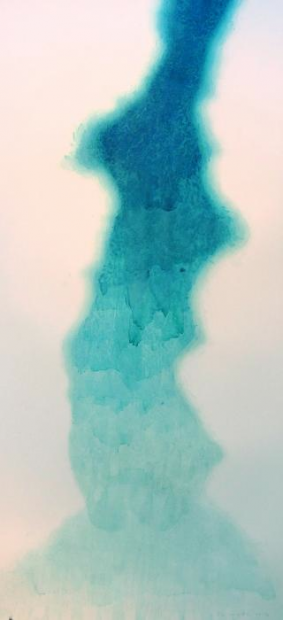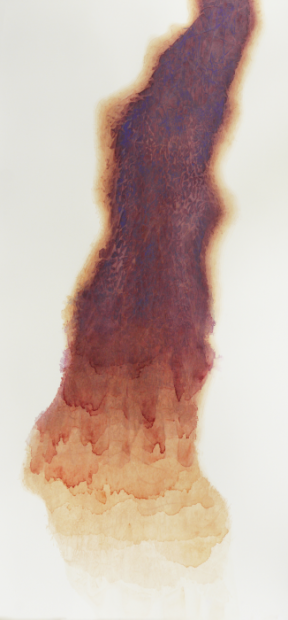The cryosphere is the area of the earth’s surface where water is in solid form, such as glaciers, ice caps, ice sheets, sea ice and permafrost. It exists in a close relationship of climactic linkages and feedback loops to the hydrosphere, earth’s areas of liquid water. The works in this exhibition explore the fluctuating zone between hydrosphere and cryosphere, between water and ice.
– Liz Ward, from artist statement for exhibition
In Liz Ward’s series of watercolors on paper, glacial forms slowly diffuse and vanish, “ice balloons” condense and reverberate in intensifying concentric rings of color and detailed silverpoint drawings capture the delicate striations of ice core layers that record, like tree rings, climatic change. Contemplative, sublime and melancholic, Ward’s series resonates with the natural processes they depict through a sensitive and meticulous making, begging the bigger questions: What do we lose when we accelerate the destruction of our natural world, in this case the melting glaciers? Can art help us empathize with the natural world and perhaps even help restore our sense of connection to it?
In the Glacial Ghost series, the viewer is brought into a direct relationship with these slices of monumental form. Human-scaled, the large watercolors are 66 inches x 32 inches (about the size of a vertical mirror). Each “glacier” begins its slowly vanishing path at the top of the painting with a dense strip of color that radiates, changes and diffuses out into thin, nearly translucent washes, as gravity seemingly pulls the pigment down the paper. The forms blur and fade at their edges with an ethereal quality that metaphorically speaks to the disintegration of the glaciers themselves.
Glacial Ghost (Fata Morgana) snakes and changes as it flows down the surface of the paper in a cool and icy aquamarine blue. The translucent washes, speckled with crystalline flecks of mica mineral, seem to almost hover off the surface of the paper, an optical effect fitting for the work’s subtitle, Fata Morgana (a Latin term for a seascape mirage, often seen in polar regions, where ships might appear to float above the ocean’s horizon line). In contrast to this painting’s coolness, Hot Glacier hits a very different emotional key with earthy oranges, reds, ochres and purples pooling together in what feels more like a fiery lava spill. The play with color and surface not only gives each painting a different mood, but opens the range of associations to the natural landscape, beyond the glacial or arctic, to speak to the dense history embedded in the slow formation of the natural world, whether sea or land.
Small studies for the large-scale watercolors show Ward’s experiments with pooling, slowly lightening edges and the cracked and textured surfaces. As she mentions in her statement, her aim is to “explore the fluctuating zone … between water and ice,” and her controlled use of the watercolor materials allows her to create surfaces that echo in very direct, physical ways the cracks and fissures of ice. Laying crinkled glassine on the pools of watercolor as they dry, Ward then removes the paper to make marks and indentations that are nearly impossible to see in photographs.
Standing in front of the Glacial Ghost paintings, I thought about how they fit into a history of abstraction (making my own superficial associations with Barnett Newman’s zips, Clyfford Still’s jagged shapes and Morris Louis’s stains), but also how the work departs and injects a political, environmental consciousness into abstract form. The properties of the material world of painting are bound to the natural world’s same physical laws. Ward exploits this to absorb and embody the subject of the melting glaciers in the material, technique and form. Beyond a simple reference to a political cause that might inform a viewer, the experience of charting my way through their intricate surfaces and landscapes made something as foreign and removed as the arctic feel real.
Liz Ward
Cryosphere
Moody Gallery
Closes November 21
FULL DISCLOSURE: Liz Ward was my painting professor at Trinity University.







1 comment
I would really like to see an exhibit by Ms. Ward…..Will she be showing in San Antonio in the new year? Her work is very refreshing.